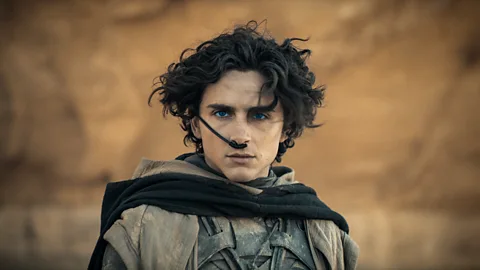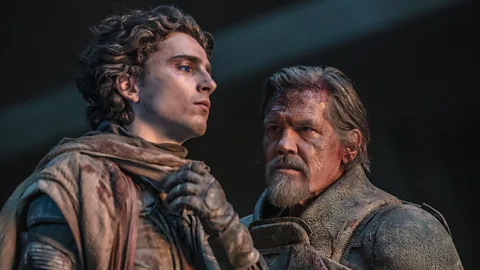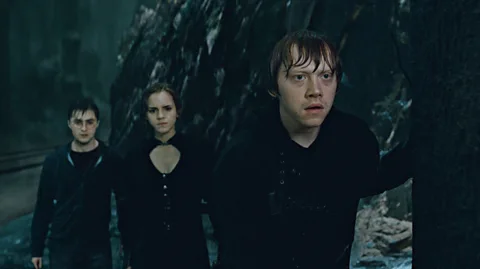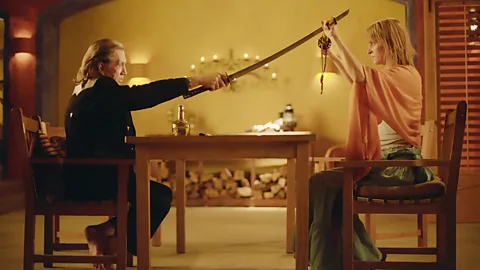By Hanna FlintFeatures correspondent

 Warner Bros
Warner Bros
From the Dune films to the new adaptation of hit musical Wicked, the trend is for big movies to be split into two instalments to tell their story. But is this what fans really want?
A ticket to the cinema has typically guaranteed a viewing experience including a beginning, a middle and an end – all contained within one film. In recent years, however, cinematic storytelling has become a game of two halves with Hollywood serving up a string of two-part movies. These include Denis Villeneuve’s sci-fi epic Dune, whose second instalment hits screens today; Zach Snyder’s own space opera Rebel Moon, with Part One: A Child of Fire released on Netflix last December and Part Two: The Scargiver out in April; and Jon M Chu’s upcoming two-part adaptation of hit stage musical Wicked, itself an adaptation of Gregory Maguire’s Wizard of Oz prequel novel of the same name.
More like this:
Two-part films are not new, but there are certainly a lot of them these days. So why is that? The bottom line is the obvious answer, with major studios keen to squeeze as much commercial juice out of their intellectual property purchases. “If you have something you know people are excited to see and that you believe you will profit on, it makes sense to try to make twice as much net profit by dividing it into two parts,” as Franklin Leonard, film executive and founder of the annual screenplay survey The Black List, puts it to BBC Culture.

 Warner Bros
Warner Bros
That was the case in the 2010s when several young adult franchises, based on major book series, began splitting their final instalments into two. The move proved most successful for Harry Potter and the Deathly Hallows (part one made under $1bn and part two took over $1.3bn) and The Twilight Saga: Breaking Dawn (part one made approximately $712mn and part two $848mn) with built-in fans and audiences relishing the expanded time with these characters.
But the adaptation of the final Hunger Games book, Mockingjay, saw a significant drop in ticket sales for part two. This was likely due to the unsatisfying story delivered in its part one predecessor and, according to director Francis Lawrence, the year wait for the conclusion: “What I realised in retrospect – and after hearing all the reactions, and feeling the kind of wrath of fans, critics and people at the split – is that I realised it was frustrating,” he told People magazine last year.
Not long afterwards, Lionsgate shelved Ascendant – the second in the planned two-part finale of the Divergent film series, based on Veronica Roth’s novels – because the first part, Allegiant, proved a commercial and critical failure. Writing for Rolling Stone, Peter Travers described the film as “another one of those cynical Hollywood cash grabs that takes the third book in bestselling juvie-lit trilogy and stretches that last book into two movies so audiences are tricked into paying twice for egregiously padded piffle.”
The commercial imperative
For Jon Thompson, British film producer and post-production consultant, that particular wave of two-parters was indicative of a studio culture, “so desperate to create revenue that they churn out carbon copies of each other”. Nowadays, he suggests the two-parter push is symptomatic of a wider pressure for studios to compete with streaming services in a bid to entice audiences with their big-screen offerings. “Almost effectively, they’re making movies on a subscription model because they’re going, “Oh well, if there’s a part one you need to see part two,” he says.
Audiences, who subscribed to the Marvel Cinematic Universe and its superheroes for 10 years, were rewarded with a two-part conclusion to its so-called First Phase, with Avengers: Infinity War and Avengers: Endgame. Originally titled Infinity War – Parts One and Part Two, they successfully use the cliffhanger of the Avengers losing the battle against Big Bad Thanos at the end of Infinity War, to entice fans back to see if they could ultimately win the war in Endgame. “It did exceptionally well and made everybody chomp at the bit to see the next one,” recalls Lucy V Hay, screenwriter and script editor. “Everybody was desperate to see Endgame.”

 Universal
Universal
George Lucas previously used this sort of storytelling model to acclaim for the second and third Star Wars films in the original trilogy, The Empire Strikes Back and Return of the Jedi: again, the narrative flowed directly from one to the other, with a cliffhanger in the middle to ensure audiences returned. However other trilogy franchises, like The Matrix and Pirates of the Caribbean, have also used a two-parter approach for their second and third instalments (shooting them back-to-back in both cases) but with much more mixed critical results.
Curiously, both Spider-Man: Across the Spider-Verse and Mission Impossible: Dead Reckoning were supposed to have Part Two films coming, but now that plan has been shelved, and the new films in these franchises will come by their own names to make clear they are individual films in their own right. In the case of the latter Tom Cruise-led blockbuster, that change might be due to its relatively poor box office performance. Bilge Ebiri, critic and editor at New York magazine, welcomes the change: “I love the fact that they’ve gone back and dropped the ‘Part One’ of the [Dead Reckoning] title. The story is not that important in those things, but I felt like I’d watched a full movie. It was unresolved, but it had an ending. It should have just ended on a cliffhanger that we’re then curious about.
The storytelling rationale
Beyond financial incentives, blockbuster filmmakers have championed the two-pronged approach to deliver richer and fuller stories, especially for Dune and Wicked which are both based on books set in vastly populated, fantastical worlds of sci-fi and magic. “This story’s too dense,” Villeneuve told The Times, referring to book one of Frank Herbert’s sci-fi series. “I would never make Dune as one movie. This was the only way I could succeed.” Chu made a similar defence, saying, “It would be impossible to wrestle the story of Wicked into a single film without doing some real damage to it.”
Opening up a story into two feature-length films does not suggest the scriptwriters and directors becoming lazy, but that they can afford to be more precise – Gregory Maguire
Some Wicked fans have shared their scepticism. For while the stage musical skims over a lot of the darker and more granular political detail of Maguire’s original novel, it successfully adapted it into a single two hours and 25 minutes (excluding interval) show. However Maguire believes Chu’s two-parter adaptation to be a “pertinent” approach to telling this epic story. “Quite some years ago – perhaps five or six – it was quietly proposed to me that it might arrive in two separate films. I agreed to the concept and kept my mouth shut about it,” he tells BBC Culture, adding, “Opening up a story into two feature-length films does not suggest the scriptwriters and directors [becoming] lazy, but that they can afford to be more precise, giving an exotic locale a greater chance of achieving something like verisimilitude.”
Maguire does believe this longer form of storytelling can better build the “flora, fauna and fabulousness” of a literary world like his, as well as, “make the very human drama at the centre of the story that much more immediate, urgent, and passionate”. Saying that, from what limited artwork he’s seen of the film adaptations, they haven’t quite built out the “early-industrial revolution” aesthetic from his pages, he notes. “I haven’t seen the film(s) but the Oz that seems to be on view is as candy-coloured as the original Munchkinland in the 1939 [Wizard of Oz] film, and that is less true of my Oz, which was more agrarian in the outback and more [industrial] in the urban settings. More Dickens and less Disneyland, in other words.”

 Alamy
Alamy
There is historical precedence for the two-parter being employed by auteurs unwilling to sacrifice the length and breadth of the narratives they want to tell. Ebiri points to Bernardo Bertolucci’s historical epic 1900 (1976) as an early example. With an original director’s cut running to an astonishing five hours 17 minutes, the film explores the friendship of landowner Alfredo Berlinghieri (De Niro) and peasant Olmo Dalcò (Depardieu) against the Italian political backdrop of fascism and communism in the early 20th Century.
When 1900 first premiered at the Cannes Film Festival in May 1976, it did so in two parts, as was Bertolucci’s wish. However, for the US market, producer Alberto Grimaldi was contractually obliged by Paramount Pictures to release it as one film, and so, after some wrangling between him and Bertolucci, they cut it down to run straight through in a 4 hour seven minute version. Nevertheless, it was still released in two parts in Italy, Denmark, Colombia, Pakistan and Japan. “The effect that movie has on people is very different in part one and part two,” Ebiri tells BBC Culture. “Part one is so lyrical, pastoral and beautiful, and part two is a flag-waving, communist epic.”
With Dune Part One, I felt like I was watching ships landing and docking for two hours. Then the story kicked in at the end, and the movie ended – Bilge Ebiri
That distinctive, bipartite narrative quality can be seen in Kill Bill Vols 1 & 2, which Quentin Tarantino had originally intended to make as one movie. Thompson, who worked on post-production on Vol 1, says the decision to expand it into two parts came during the editing process. “They realised that if they tried to make it work in two hours, it became very constrained,” he recalls. “So they extended it and shot a few more sequences. They put all the backstory in Vol 2 and then fleshed it out – It’s almost like seeing the other half of the coin.” Ebiri agrees the films work as discrete products but some of his peers at the time disagreed. “I had a lot of critic friends who aren’t keen on Vol 1 because it felt incomplete to them, which is understandable, and then Vol 2 came out and a lot of people loved it,” he says. “Not because it completed the story but because it was, narratively, more satisfying in a variety of ways. The two parts are so distinctive that nobody really thinks of it as one movie still to this day.”
Hay does point out that not all filmmakers get the sort of narrative freedom that Bertolucci, Tarantino and even Villeneuve enjoy. “They’re all considered auteurs so in that sense, they’re pretty much allowed to do whatever they want, and it’s no accident that men get that kind of privilege in cinema in a way that female directors just don’t.” Joanna Hogg’s The Souvenir part one and part two is one of the few examples of a female director given creative licence to deliver their story in two parts, likely in part due to Martin Scorsese’s backing as an executive producer.
Does it benefit fans?
Audiences will have to wait until November to decide whether Wicked part one makes good on Chu’s promise to “tell the story of Wicked as it was meant to be told” but while the critical consensus for Dunes part one and two has been mostly positive, there have been some caveats expressed related to its two-part format in particular. Released in 2021, towards the end of the pandemic, the first part made $434.8mn against a $165mn budget. It was praised for its awe-inspiring word-building and cinematic vision, but the biggest criticism made about it was the creative decision to serve only half of the book’s narrative arc and meanderingly plot it over a two-and-a-half-hour runtime. “This film is a curiously paradoxical achievement,” wrote Slate’s Dana Stevens. “A visual and aural marvel that is also a crashing bore.”

 Alamy
Alamy
Dune part one’s anticlimactic ending similarly underwhelmed Ebiri. “I felt like I was watching ships landing and docking for two hours,” he tells BBC Culture. “Then the story kicked in at the end, and the movie ended. I said at the time, ‘Well, I’m not sure I liked that but I’m looking forward to Dune Part Two when the actual story kicks in.”
Rebel Moon Part One: A Child of Fire earned far less acclaim but much of the criticism was also directed towards its curtailed plotting. “I was all for Rebel Moon as a concept when it was announced – the fact that it was [intended as] a Star Wars movie [Lucasfilm passed on Snyder’s pitch] and he made it anyway,” says Ebiri, “But you spend the first movie getting The Seven Samurai [-esque team] in place and run out of time to give us anything else. The team narrative has to work on its own as a movie and it doesn’t.”
Despite the first part’s disappointing critical response, it remains to be seen whether Rebel Moon: Part Two can save the day. Meanwhile, Dune Part Two might conclude the first Dune book’s story, but a cliffhanger ending all but confirms a sequel based on Dune Messiah, the second book, will soon follow. This sort of extended franchise cinema is of course becoming increasingly the norm. But if Hollywood does continue to split films into two, then it may need to think harder about how to make these movies satisfying in their own right, so as not to make audiences feel cheated or ripped off. “For a movie to be commercially successful, it needs either be a discrete thing that someone could watch having no knowledge of previous things or needing to watch something else,’ suggests Leonard. “Or it needs to offer enough of a compelling reason to come back for [part two]; otherwise, it’s a bust.”
Dune Part Two is in cinemas internationally now
If you liked this story, sign up for The Essential List newsletter – a handpicked selection of features, videos and can’t-miss news delivered to your inbox every Friday.
If you would like to comment on this story or anything else you have seen on BBC Culture, head over to our Facebook page or message us on Twitter.





